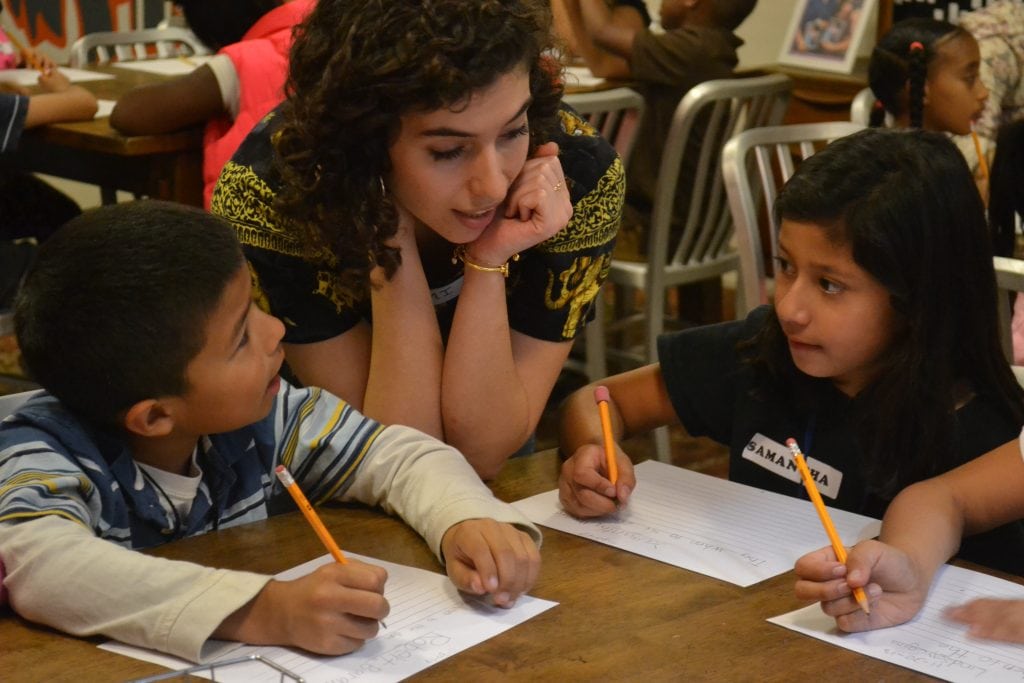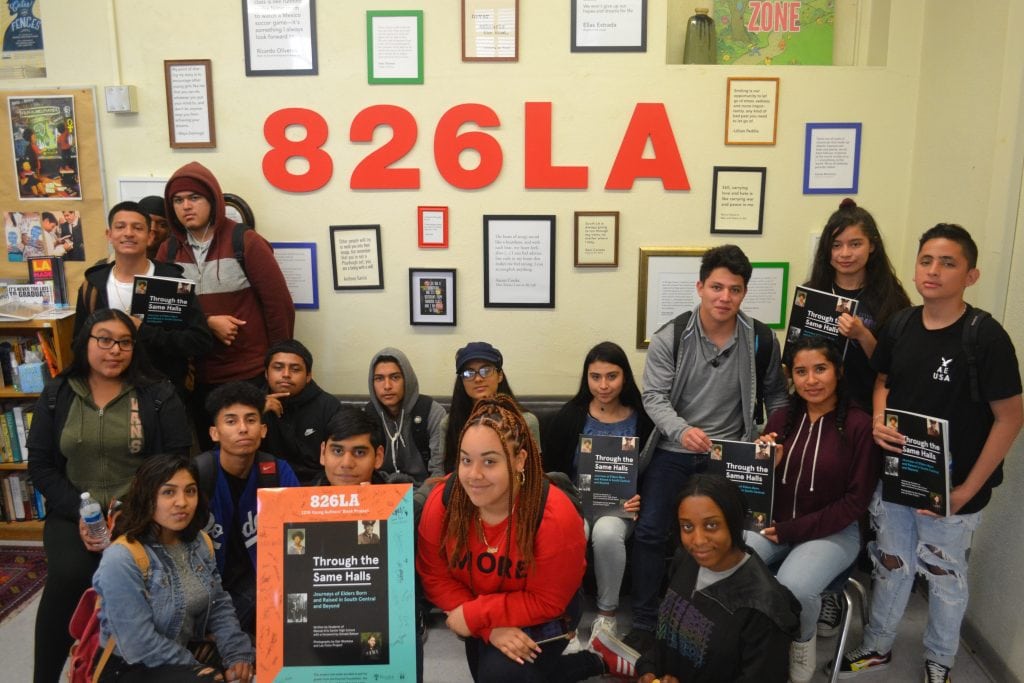
A volunteer works with students during after-school tutoring at 826LA in Mar Vista. PHOTO COURTESY 826LA
It’s tough to watch your child struggle in school. As parents, we instinctively step in and try to offer some extra help. Sometimes, that’s enough. But as curriculum and methodologies continually change, you may feel challenged, too. And, let’s face it, not every parent is great at homework help. Perhaps it’s time t
o consider a tutor. Though there’s no one-size-fits-all solution, tutoring may be just what your child needs to become confident and successful in school. Here is some guidance from tutoring professionals to help you decide whether a tutor is right for your child.
Know the Signs
If your child is hesitant or unwilling to talk about classes or grades, or they just stop talking about school altogether, it could indicate a problem, says Rand Bleimeister, executive director and owner of seven Sylvan Learning locations in L.A.
Homework habits are another telltale sign. “If you don’t see them doing homework, or they say they don’t have homework, they may be struggling,” Bleimeister says. “It’s rare, especially at the middle- and high-school levels, that a child doesn’t have any homework.” Not sure what your child’s homework situation is? Talk with the teacher or check your child’s online school portal to see what homework has been assigned and how your child has been doing on past homework assignments.
If homework takes your child a very long time, Candice Lapin, founder of L.A.-based education and tutoring company The Ladder Method, says this could be a sign that your child is overwhelmed by school. “If a child is drowning in work, it’s a struggle,” Lapin says. Homework may take a little extra time during the initial transition to a new grade level or a new subject, but that shouldn’t continue.
Homework struggles often indicate a deeper issue, which could include skill gaps. These happen when a child misses class and doesn’t have the chance to pick up, or simply doesn’t master, a skill or set of skills that are necessary building blocks for learning new skills. Even a B student might not know the material. “The system just pushes them through,” says Bleimeister. “A and B students still have skill gaps. The problem may be now or not until the next grade up.” Eventually, though, it will show itself and become an issue. The sooner the skill gap is recognized, the better, because the self-esteem of a child who continues to fall further behind will suffer. By sixth or seventh grade, children are forming their identities, says Bleimeister, and it’s important that they have the pride and confidence to move forward academically.

Candice Lapin, right, founded The Ladder Method and suggests starting with referrals from your child’s school if you need to seek out a tutor. PHOTO COURTESY THE LADDER METHOD
Start with the Teacher
If you suspect something is wrong at school, contact your child’s teacher first. “There could be a simple solution,” explains Lapin, “but start involving school in the discussion.” Teacher insight is the ideal starting point because the teacher observes a child’s classroom behavior, which includes engagement, participation, focus and performance on assignments and assessments.
The teacher should be able to identify “specific subject-matter content areas that could be improved, first in the classroom setting and with a tutor, if needed,” says Julianne Reynoso, assistant superintendent of elementary instruction for the Pasadena Unified School District (PUSD).
Reynoso recommends scheduling an appointment with the teacher and the school’s administrative team to begin developing a plan for improvement. This conversation can determine whether it’s math lab help or closer observation throughout the school day that’s needed.
Tap Local Resources
Your child’s school will more than likely offer academic support, and there might be a homework club, peer tutoring, after-school tutoring or other programs within the school. PUSD, for example, partners with a variety of organizations, including Reading Partners, which works with students during the school day to improve reading skills.
Throughout the L.A. area, you’ll find amazing educational partnerships offered within schools, as well as resources in the community. One such resource is the nonprofit 826LA, which works directly with schools and through its community learning centers to offer a free tutoring program to high-needs schools.
A special focus of 826LA is on writing. “Writing is essential,” says Executive Director Joel Arquillos. “It’s a vital element in your life.” Run by volunteers, 826LA brings its writing program to classrooms and hosts class field trips at its locations in Echo Park and Mar Vista. The program is always project-based and can include helping a teacher with a project, helping a student with a college essay or helping kids write and publish books.
A field trip to 826LA places students in a publishing house, which Arquillos describes as “a fun, engaging way to trick kids into creating books.” Kids experience every step of the process. There’s a writers’ room, an illustrator and typists. The idea is to help young people feel confident in who they are, discover their voices, tell their stories and understand that what they have to say and how they view the world is valuable. “It helps them see the possibilities,” says Arquillos. “We’re building on their strengths. We see students as all being capable of producing good work. We want to spark that love of learning.”
Workshops are also open to the general public, including some on select Sundays at the Hammer Museum in Westwood.
Call for Help
If you’re not seeing improvement with the help of school and community resources, it’s time for the next step. If your child has hit a wall in understanding or is struggling with basic organization and study skills, consider having your child tested for gaps in essential skills, or for a learning disability. Public schools provide testing for learning disabilities and, if a child is diagnosed, will put accommodations into place through an Individualized Education Program (IEP).
Another diagnostic test to consider is an academic assessment to check for skill gaps, Bleimeister says. Sylvan will test your child for a nominal fee, which includes the test, a copy of the results and a talk with someone to help interpret the results, identify skill gaps and craft an individualized learning plan. Skill gaps can often be addressed through individual tutoring with a professional.
When seeking out a tutor for your child, Lapin recommends starting with referrals from your school. This will mean multiple families have used and trusted the tutor or tutoring service. Be sure the tutor has experience in tutoring, she says, because tutoring is different from teaching. You might want your child’s tutor to be a certificated teacher, but make sure that person has experience in the subject and the level in which your child needs help. In addition, consider the differences between a tutoring service, which has already done background and qualification checks and has several tutors from which to choose, and an individual tutor for whom you’d have to do the groundwork.
Find the Right Fit
It’s also important to ask what the tutor will cover in each session, says Erin Parucci, a tutor at The Learning Connection, a tutoring service in West Los Angeles. Will they cover or reteach basic concepts for better understanding? Clearly communicate your expectations so your child’s goal for success is understood. It’s a good idea to involve your child in the selection process. Ask whether your child likes the prospective tutor and whether she’d like this person to help her improve in school. Be clear about whether your child will be tutored at home or at the tutoring site. One environment may better suit your child’s and your family’s needs than the other.
Once your child begins with the new tutor, you’ll want to see signs of improvement. “Progress should be measured in a child’s demeanor and attitude toward school, teacher input and grades or progress report,” says Parucci. “If a child starts to enjoy school and doesn’t complain and is motivated, these are usually signs that they are improving.”
Of course, grades might not change quickly and improvement may be slow, especially if there are skill gaps to close. But, Bleimeister says, look for an improvement in confidence. A tutor can make a child feel less alone, and more supported and confident. “This is improvement,” he says. This will bring about a willingness to try tough new things that accelerate growth – a muscle your child will continue to build upon and carry into all aspects of life, far beyond academics.
Lori Zanteson is an L.A. native who is raising three teenagers, teaching high school English and happily writing about both.





























